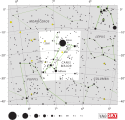Pi Canis Majoris
| Pi Canis Majoris (π) | |
 | |
| Observationsdata Epok: J2000.0 | |
|---|---|
| Stjärnbild | Stora hunden |
| Rektascension | 06t 55m 37,43099s[1] |
| Deklination | -20° 08′ 11,3902″[1] |
| Skenbar magnitud () | +4,69[2] |
| Stjärntyp | |
| Spektraltyp | F1.5 V[3] |
| U–B | +0,06[2] |
| B–V | +0,36[2] |
| Astrometri | |
| Radialhastighet () | -37,9 ± 5,5[4] km/s |
| Egenrörelse (µ) | RA: +51,50[1] mas/år Dek.: +39,58[1] mas/år |
| Parallax () | 33,80 ± 0,24[1] |
| Avstånd | 96,5 ± 0,7 lå (29,6 ± 0,2 pc) |
| Absolut magnitud () | +2,06[5] |
| Detaljer | |
| Massa | 1,32[6] M☉ |
| Radie | 2,29[7] R☉ |
| Luminositet | 9[8] L☉ |
| Temperatur | 6 863 ± 233[6] K |
| Metallicitet | −0,18[3] dex |
| Vinkelhastighet | 91,7 ± 4,6[5] km/s |
| Ålder | 763[6] miljoner år |
| Andra beteckningar | |
| π CMa, 19 Canis Majoris, BD-19° 1610, HD 51199, HIP 33302, HR 2590, SAO 172579, ADS 5602, CCDM 06556-2008 [9] | |
Pi Canis Majoris (π Canis Majoris, förkortat Pi CMa, π CMa) som är stjärnans Bayerbeteckning, är en dubbelstjärna[10] belägen i den mellersta delen av stjärnbilden Stora hunden. Den har en kombinerad skenbar magnitud på 4,69[2] och är synlig för blotta ögat där ljusföroreningar ej förekommer. Baserat på parallaxmätning inom Hipparcosuppdraget på ca 33,8[1] mas, beräknas den befinna sig på ett avstånd av ca 97 ljusår (ca 30 parsek) från solen. Stjärnan rör sig i riktning mot solen med en radiell hastighet på -37,9 km/s och kommer att vara på minsta avstånd om ca 733 000 år, då med 23 ljusår.[4]
Egenskaper
Pi Canis Majoris A är blå till vit stjärna i huvudserien av spektralklass F1.5 V[3]. Den har en uppskattad massa som är 1,32[6] gånger större än solens, en radie som är ca 2,3[7] gånger större och utsänder från dess fotosfär ca 9[8] gånger mera energi än solen vid en effektiv temperatur på ca 6 860[6] K. Den visar ett stort överskott av infraröd strålning vid en våglängd på 24 μm och ett mindre överskott vid 70 μm, vilket tyder på närvaron av en omgivande skiva av stoft med en temperatur på 188 K, som kretsar på ett avstånd av 6,7 AE från stjärnan.[11]
Pi Canis Majoris A är en periodisk variabel stjärna med en frekvens på 11,09569 cykler per dygn (2,16 timmar per cykel) och en amplitud på 0,0025 i magnitud.[12] Den har en följeslagare, Pi Canis Majoris B av magnitud 9,6, som år 2008 var separerad med 11,6 bågsekunder från primärstjärnan.[10] Den projicerade separationen är ca 339 AE.[11]
Källor
- Den här artikeln är helt eller delvis baserad på material från engelskspråkiga Wikipedia, tidigare version.
Referenser
- ^ [a b c d e f] van Leeuwen, F. (2007), "Validation of the new Hipparcos reduction", Astronomy and Astrophysics, 474 (2): 653–664, arXiv:0708.1752 , Bibcode:2007A&A...474..653V, doi:10.1051/0004-6361:20078357.
- ^ [a b c d] Johnson, H. L.; et al. (1966), "UBVRIJKL photometry of the bright stars", Communications of the Lunar and Planetary Laboratory, 4 (99), Bibcode:1966CoLPL...4...99J.
- ^ [a b c] Gray, R. O.; et al. (July 2006), "Contributions to the Nearby Stars (NStars) Project: spectroscopy of stars earlier than M0 within 40 pc-The Southern Sample", The Astronomical Journal, 132 (1): 161–170, arXiv:astro-ph/0603770 , Bibcode:2006AJ....132..161G, doi:10.1086/504637.
- ^ [a b] Bailer-Jones, C. A. L. (March 2015), "Close encounters of the stellar kind", Astronomy & Astrophysics, 575: 13, arXiv:1412.3648 , Bibcode:2015A&A...575A..35B, doi:10.1051/0004-6361/201425221, A35.
- ^ [a b] Reiners, A. (January 2006), "Rotation- and temperature-dependence of stellar latitudinal differential rotation", Astronomy and Astrophysics, 446 (1): 267–277, arXiv:astro-ph/0509399 , Bibcode:2006A&A...446..267R, doi:10.1051/0004-6361:20053911.
- ^ [a b c d e] David, Trevor J.; Hillenbrand, Lynne A. (2015), "The Ages of Early-Type Stars: Strömgren Photometric Methods Calibrated, Validated, Tested, and Applied to Hosts and Prospective Hosts of Directly Imaged Exoplanets", The Astrophysical Journal, 804 (2): 146, arXiv:1501.03154 , Bibcode:2015ApJ...804..146D, doi:10.1088/0004-637X/804/2/146.
- ^ [a b] https://www.universeguide.com/star/picanismajoris. Hämtad 2017-12-24.
- ^ [a b] McDonald, I.; et al. (2012), "Fundamental Parameters and Infrared Excesses of Hipparcos Stars", Monthly Notices of the Royal Astronomical Society, 427 (1): 343–57, arXiv:1208.2037 , Bibcode:2012MNRAS.427..343M, doi:10.1111/j.1365-2966.2012.21873.x.
- ^ "pi. CMa". SIMBAD. Centre de données astronomiques de Strasbourg. Hämtad 2017-09-03.
- ^ [a b] Eggleton, P. P.; Tokovinin, A. A. (September 2008), "A catalogue of multiplicity among bright stellar systems", Monthly Notices of the Royal Astronomical Society, 389 (2): 869–879, arXiv:0806.2878 , Bibcode:2008MNRAS.389..869E, doi:10.1111/j.1365-2966.2008.13596.x.
- ^ [a b] Trilling, D. E.; et al. (April 2007), "Debris disks in main-sequence binary systems", The Astrophysical Journal, 658 (2): 1264−1288, arXiv:astro-ph/0612029 , Bibcode:2007ApJ...658.1289T, doi:10.1086/511668.
- ^ Koen, Chris; Eyer, Laurent (2002), "New periodic variables from the Hipparcos epoch photometry", Monthly Notices of the Royal Astronomical Society, 331: 45, arXiv:astro-ph/0112194 , Bibcode:2002MNRAS.331...45K, doi:10.1046/j.1365-8711.2002.05150.x.
Externa länkar
| |||||||||||||||||||
Media som används på denna webbplats
Författare/Upphovsman: IAU and Sky & Telescope magazine (Roger Sinnott & Rick Fienberg), Licens: CC BY 3.0
IAU Canis Major chart


